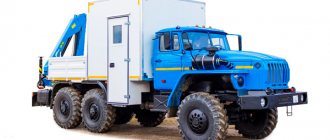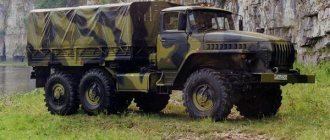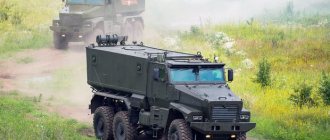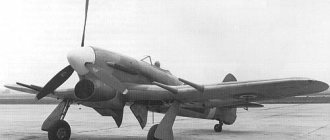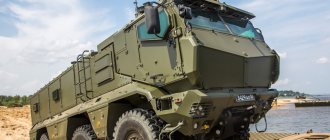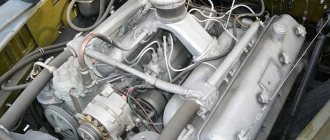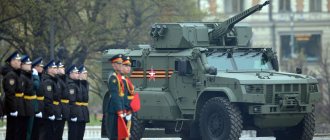“The new Typhoon-U is a taxi for “polite people.” This beast will withstand both explosion and shelling,” Russian Deputy Prime Minister Dmitry Rogozin wrote on his website after visiting the Ural automobile plant. And two weeks after that, I got acquainted with the Ural Typhoon - and with the newest version of the Ural-63095U, which the press had not yet known about!
There is a lull at the training ground in Bronnitsy near Moscow, where army equipment is being tested. Only in the distance, raising clouds of dust, a tracked vehicle with a camouflaged installation on its “hump” rushes with a roar.
And in the summer of 2011, there was nowhere for the apple to fall: the military held a large-scale show of cars. Just then, the latest Typhoons - KAMAZ and two Urals - were demonstrated to the Minister of Defense of the Russian Federation (but still in a closed exhibition). And photographer Stepan Schumacher and I waited until the show was over and were the first to take great pictures of these armored cars coming out of hiding!
Then, in Bronnitsy, it was announced that the Typhoon was a promising family of highly protected armored vehicles. The contractors are the mentioned KAMAZ and the Ural automobile plant, the project completion date is 2014.
And now this year has come: tests continue, but each of the factories has already received an order for a pilot batch of 30 copies, and KAMAZ vehicles (they are called Typhoon-K) walked along Red Square at the parade on May 9.
And in front of you is Typhoon-U, “Ural”. How far our defense industry has come lately! Fifteen years ago, here in Bronnitsy, I photographed an ordinary Ural with armor plates simply screwed to the cab doors (such trucks fought in Afghanistan and Chechnya). And the car in our pictures doesn’t even resemble the design of ordinary Ural trucks! According to international terminology, this is a typical heavy MRAP (Mine-Resistant Ambush Protected, “protected from mine explosions and ambush attacks”) - neither a truck nor an armored personnel carrier.
We recently talked about the explosion-proof “armored vehicles” Ural Federal-M and Ural-VV for internal troops of the Ministry of Internal Affairs in hot spots (AR No. 24, 2013). But they are based on a serial chassis, but the Typhoons received a completely original design - and an original chassis.
Typhoon vs Typhoon
What is common in the design of the Kama Typhoon-K and the Ural Typhoon-U is an independent and adjustable suspension on all wheels, an automatic transmission, an on-board information and control system (BIUS), combat-resistant wheels that allow movement if damaged, and very powerful armor protection.
The first samples of Tyfunov-U, built in 2011: modular Ural-63095 (front) and single-volume Ural-63099. Round headlights with LEDs and octagonal “nut” housings are clearly visible
In the first samples, it was made completely “heavy-duty”, from a heavy machine gun (the thickness of the armored glass is 130 mm!). Kamaz even dreamed of protecting the “forehead” of one of their models from a 30-mm cannon. But such a “shell” is very heavy, and also requires the use of expensive ceramics.
Two-axle Ural-53099: according to our information, it was made from a three-axle Ural-63099 (Photo by Sergei ORLOV)
Therefore, according to our information, the current Typhoons received armor that is more traditional for armored vehicles and less weighty - according to the highest class of GOST "6a", from armor-piercing incendiary bullets of the Dragunov sniper rifle, not to mention the Kalashnikov assault rifle. By the way, armored personnel carriers have similar side protection (their “forehead” is more powerfully armored).
But, unlike armored personnel carriers, which are not designed for explosions, Typhoons must withstand the explosion of a mine or land mine weighing up to 8 kg: armored modules have a V-shaped bottom that dissipates the effect of the shock wave, the body and cabin are raised high above the ground, the seats are suspended from the walls and ceiling .
Serial production of Typhoons-U in the workshop of the automobile plant (facebook.com/dmitry.rogozin)
The armored hulls, cabins and tail of the Typhoon-U are welded at the Moscow Research Institute of Steel (Photo of the Research Institute of Steel)
0 / 0
And the main difference between the armored cars of KAMAZ and the Urals is also partly related to explosion protection. The fact is that each of the plants remained faithful to its traditional layout: Typhoons-K are cabover, and Typhoons-U are “nosed”. Surely the KAMAZ team has its own arguments, but if a mine explodes under the front wheel of a bonneted vehicle, the impact will fall on the engine, and in a cabover one - on the cabin... In addition, hooded trucks are easier to maintain the engine and are easier to make “single-volume”, combining the interior with cabin.
Kamazov Typhoon-K at the parade on May 9 in Moscow. Seeing the cars, the children asked: “Where do these armored personnel carriers have a gun?” and “Why are they driving backwards?” The point is the unusual arrangement of the bridges: due to the heavy front part, two bridges are located in front, and not behind, as usual (Photo by Konstantin ZAKURDAEV)
There is another important difference between the Typhoons of both brands - we would say strategic. Kamaz uses the American Allison automatic transmission, German armored ceramics, and French combat-resistant wheels with inserts. All this, firstly, increases the already considerable price of the car. And secondly, is the use of components from “potential enemy” countries justified, especially in the current conditions? The same Rogozin recently called on the Russian defense industry to abandon import purchases!
History of origin
The idea of creating a unified automobile chassis arose in the USSR by the beginning of the 80s. To implement the project, the Garage program was launched, which was closed due to the collapse of the country and the cessation of funding.
The idea was returned only in 2010, when families of armored vehicles with a high degree of unification began to appear again within the framework of the concept of development of the armed forces.
The first prototypes of the vehicles began to be tested in the early summer of 2011 at the Bronnitsy training ground.
The largest factories in the Russian Federation for the production of civilian and military trucks, as well as a number of universities (creating the geometry of the armored hull and developing a hydromechanical transmission) took part in the creation of armored vehicles.
Deliveries of armored vehicles to the troops began at the end of 2014, when the first pilot batch of 30 vehicles was delivered.
On a Minsk chassis
The first Ural Typhoons were designed to match the Kama ones: they had Allison automatic transmissions, armored ceramics, axles with independent adjustable suspension of our own design, clever headlights with lens optics and built-in LED turn signals.
The rear ramp lowers quickly and almost silently
But when it came to serial production, the cars were simplified (for example, the headlights became traditional, rectangular), lightened by one and a half tons and “transplanted” to a new chassis. Do you know which one?
The ramp has a comfortable footrest, ribs to prevent shoes from slipping, and a built-in emergency door
Under the body there are hydraulic cylinders for the ramp drive
0 / 0
On the hub caps of the truck I got acquainted with, “Volat” is written - this is a trademark of the Minsk MZKT plant, which traditionally produces chassis for rocket carriers. It turns out that Minsk residents supply axles, independent suspension with hydropneumatic struts, and even an automatic transmission for the Typhoon-U. No imports from Europe!
Under the armored hood is a Yaroslavl 450-horsepower “six” that meets Euro 0 standards. Anti-traumatic seats are suspended from the walls and ceiling and equipped with footrests so that the blast wave is not transmitted to the legs through the floor. Where is the soft anti-fragmentation protection?
The armor protection is completely Russian: the module hulls (no longer octagonal, as on the first copies, but with vertical sides), cabins and tail surfaces are welded at the Moscow Steel Research Institute, armored glass is supplied by the Magistral company from Gus-Khrustalny.
What's under the hood? Climbing up the retractable step onto the bumper, I turn two handles, lift the heavy hood on gas springs... Underneath it is the new in-line Yaroslavl YaMZ-536, which we talked about in AR No. 22, 2013. Of course, it couldn’t be done without imported components: for example, injection common rail, electronic control unit and sensors - Bosch, turbocharger - Borg Warner, filters - Mann+Hummel (by the way, the fuel separator filter is located inconveniently, deep in the engine compartment).
“Volat” is written on the hub covers - this is a trademark of the MZKT plant!
But if such engines in the “civilian” version develop no more than 310 hp, then this version with the YaMZ-5367 index is 450 hp. It turned out that it was created specifically for Typhoons, and in Euro 0 performance, which is what the military requires. This explains such a high power: this is how you can “overclock” a seven-liter turbodiesel, if you don’t “strangle” it with environmental standards! In addition, the design is multi-fuel: the motor is capable of “digesting” diesel fuel that does not meet any standards. True, according to the experience of test engineers, when filling with diesel fuel of different quality, the characteristics will “float”.
This is what the independent rear suspension looks like...
…and from the front: hydropneumatic struts are clearly visible
0 / 0
As for fuel consumption, judging by the advertising leaflet, it is 42 l/100 km, but “in ideal conditions”, when driving on a flat road at a speed of 60 km/h. Surely, off-road and in “combat” modes, consumption increases significantly.
Therefore, aren’t two 210-liter fuel tanks too small? By the way, the tanks have a self-sealing coating (it will prevent diesel fuel from leaking out if the tank is punctured), but we would also cover them with steel armor, although this will increase the weight of the armor protection. But the air conditioning fans (behind the grille above the right tank) clearly need to be better protected or moved to a safer place: if they are damaged, the crew will be left without fresh air.
The tanks have a self-sealing coating, but the air conditioning fans (behind the grille) are not sufficiently protected
This is how an armored module with a V-shaped bottom is attached to the frame
0 / 0
Projected upgrades
One of the promising developments is the KamAZ-4386 or Typhoon-D hooded armored car, equipped with two axles and intended for arming airborne troops. The armored vehicle is adapted for landing and is equipped with a remote-controlled turret with a heavy machine gun. To lighten the design of the vehicle, a load-bearing armored hull is used.
The design made it possible to reduce weight by 2 tons compared to the 53949 machine.
The power unit is expected to be a 350-horsepower Cummins diesel engine and an automatic transmission with two axles. The design speed of the vehicle exceeds 105 km/h, and the range on the highway is up to 1200 km.
UAZ
Today, the Ulyanovsk Automobile Plant's model range consists of three families of vehicles: Hanter, Patriot, LCV and MPV (all-wheel drive commercial minibuses and trucks, in other words, UAZ-2206 and UAZ-3303). The main development of UAZ vehicles is aimed at using a single unit platform on which three different families of engines will be installed: gasoline ZMZ-409.10 (Euro 2), diesel ZMZ-5143.10 (Euro 2) and imported diesel engine (Euro 3, 4), as well as common mechanical 5-speed gearbox made by South Korean Dymos, two-speed transfer case UAZ and solid axles made by UAZ. Already this year, most of the plans should be implemented on production cars, in particular the installation of Dymos gearboxes on all cars. In 2007, it is planned to install imported diesel engines on the Patriot family, and in 2008, the development of a new exterior and interior for the same Patriot family.
The Ulyanovsk Automobile Plant has developed a new UAZ-2970 car with a diesel-electric motor-transmission unit. A vehicle with a ZMZ-5143 diesel engine is equipped with a generator and two traction motors. Together with MAMI, a completely new modular body of a command vehicle with the possibility of hidden armor has been created, which, if desired, can be installed on the UAZ-2970 chassis.
Principles of cooperation between the Moscow Region and car factories
For the Ministry of Defense and automobile industry enterprises, the issues of further technical improvement of manufactured car models, the creation of new, more efficient models and the organization of their mass production are of great importance. To solve them, fundamental principles of joint work have been developed.
Firstly, a qualitative increase in the technical level of the cars being created is required. The Ministry of Defense will finance only those works that will bring a significant increase in the main performance characteristics, and will purchase only those samples that are more consistent with the requirements and purpose. Factories can and should engage in phased modernization at their own expense during mass production. The dominant principle remains the creation of military vehicles as part of unified families of various classes of carrying capacity and purpose.
Secondly, it is necessary to minimize the costs of developing and mastering the production of new types of automotive equipment by implementing the “dual-use” principle. There is a danger that this could lead to the “washing out” of a number of the most important indicators of the tactical and technical requirements mandatory for army vehicles: cross-country ability, suitability for maintenance and repair in military conditions, and the use of imported components.
Thirdly, the economic growth of enterprises in the automotive industry makes it possible to plan production development for the long term. In this regard, the parties are trying to find a harmonious combination of programs for the development of vehicle designs of different types and the development of military automotive equipment. For example, the development of commercial vehicles is now in conflict with the requirements for military vehicles. This applies to the widespread use of imported components and developed components, assemblies and vehicle systems on domestic vehicles that cannot be used in the design of military vehicles.
In turn, manufacturing enterprises must have a clear idea of the volume of purchases by the Defense Ministry of their products in order to plan the necessary investments in R&D and development of the production of army vehicles, determine the range and quantity of necessary technological equipment, payback periods for investments and other indicators. The allocated budget allocations will allow the Ministry of Defense to finance the development of only new models of automotive equipment, and the preparation of production and the organization of mass production will be carried out at the expense of manufacturing enterprises.
It is interesting to trace the prospects for the development of automobile enterprises with specific proposals to the Moscow Region. Let's start with the Ulyanovsk Automobile Plant as a manufacturer of the smallest army vehicles.
Interesting facts and combat use
During testing, the armored capsule was tested for resistance to fragments from a high-explosive projectile with a caliber of 152 mm. When a shell explodes at a distance of 2 meters from the vehicle, the fragments do not penetrate the body of the armored vehicle.
To protect the vehicle body from cumulative ammunition, it is proposed to use elastic mats connected using belts or Velcro fasteners. The design of the mats does not allow the formation of a directed cumulative jet, reducing the likelihood of penetration.
Several vehicles of the KamAZ 63968 type were used in 2022 in Syria to support sappers in clearing mines in liberated cities. There is no other data on the combat use of the vehicles.
KAMAZ
Currently, the Kama auto giant produces two groups of military vehicles for the Moscow Region. The first group includes vehicles (KAMAZ-43114 family), which should soon leave the assembly line. The second includes multi-purpose vehicles of the Mustang family. This family has been mastered in production, and the technical level of the Mustangs allows for consistent modernization of the family vehicles over the next 10 years in order to best meet the needs of the Moscow Region. On its own initiative, KAMAZ OJSC continues to constantly expand this family. In particular, this applies to the creation of cars with open and hidden cabin armor. Among the latest developments of Chelny residents, several new cars can be noted. Among them is a special four-axle artillery tractor based on the KamAZ-6350 for towing guns. The cabin, crew compartment, bottom of the power unit, gas tanks and battery compartment with hidden armor are in protection class V. The equipment includes a manipulator for loading and unloading ammunition and an on-board platform. To replace the discontinued GAZ-66 vehicles in the airborne troops, the KamAZ-43501 airborne vehicle has been prepared. The KamAZ-53501 is designed for transportation of components of the pontoon fleet, which is capable of replacing Ukrainian-made KrAZ vehicles previously used in the pontoon fleet.
KAMAZ OJSC places great hopes on the joint project with MSTU named after. Bauman developed the KamAZ-43269 “Vystrel” armored car. It is designed to accompany convoys, patrol in zones of armed conflicts, transport personnel, or even for mounting certain types of weapons. The main advantage of the Vystrel over the armored personnel carrier is its lower cost and much longer service life of the units. Currently, “Vystrel” is undergoing state tests, based on the results of which a decision will be made on the possibility of using this type of armored vehicle in the Armed Forces. In the future, Kama automakers plan to expand the Vystrel family by creating three and four-axle armored vehicles of this type, as well as create a completely new, unified family of military multi-purpose vehicles with a carrying capacity of 4 to 15 tons.

